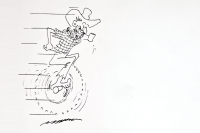Haywood tourism continues to grow
 Fiscal year 2017-18 performance of the 3 percent fund, provided by the Haywood TDA, shows robust growth.
Fiscal year 2017-18 performance of the 3 percent fund, provided by the Haywood TDA, shows robust growth.
The fiscal year for Haywood County’s Tourism Development Authority ended June 30, and now that all the data are in, it looks like 2017-18 was another banner year for overnight stays around the county.
“I think we’ve since the recession continued to see an upswing in tourism throughout the year, so I just think this is a continuation,” said TDA Executive Director Lynn Collins.
According to a report provided to Haywood County commissioners last week, each month from July 2017 through June 2018 showed growth over budgeted estimates, in some cases substantially.
Collections topped 42 percent over projections in January and 30 percent in March; the biggest months in terms of dollar volume were October, July and June, in that order and the lowest February, January and March, respectively.
Collins explained that the process by which the TDA determines projections is complicated but is meant to ensure funding is available to the qualified entities that request it.
“That money is awarded before the budget year starts, so if your projections don’t come in, then you have to go back and take that money away from those people, and that’s not pleasant,” she said.
Related Items
In 2017-18, the TDA funded a number of projects like the Lake Logan Multisport Festival, the Fines Creek Bluegrass Festival, the Lake Junaluska Independence Day celebration, Maggie Valley Fall Days and Waynesville’s Art After Dark.
“I do the projections in January, so in January I base the projections to the last full year I have,” she said, which means the 2017-18 projections were based on the 2015-16 fiscal year.
For example, actual collections for the 3 percent TDA fund in July 2017 were about $140,000, but the projection for July 2018 was about $125,000, about 10 percent less. Actual collections came in at $151,000 or about 20 percent higher.
Although it’s unusual in business to project such substantial revenue declines, Collins said there is a method to the madness. Using the previous full year’s actual collections, the board also looks at how the first four months of the current fiscal year appear to be going, and then decides to increase or decrease Collins’ baseline projections accordingly. Those projections are consistently lower than actual collections.
“I would certainly rather be under than over,” she said. “Even on the 3 percent side, we do our media plan for the whole year, and that money is technically committed, so if we’re not bringing in that money then we have to start pulling back on the media buys, and looking at staffing and everything else.”
February 2018 was the only month of the 2017-18 fiscal year that didn’t top last year’s actual collections, losing 6 percent. The biggest year-over-year gains were seen in January, September and August.
Some of that is due to the source of the money the TDA collects; by category, hotels and motels do most of the business, for most of the year, except in January, February and March, when it’s all about vacation rentals. The revenue streams, however, can essentially be boiled down to just two — hotels and non-hotels.
“In order to get a really accurate picture of this, the owners have the choice of choosing what category they want to be in, and if you really look in-depth, what you would do is add the cabins and cottages with the vacation rentals,” she said. “If you look at that, then they’re really almost neck-and-neck throughout the year.”
Each of the five zip codes represented in the TDA’s 1 percent fund showed growth over the previous year, except Maggie Valley, which was flat. Large gains were again seen at Lake Junaluska and Clyde.
“There’s just more people coming on board with inventory in Clyde,” Collins said. “Clyde’s a very large zip code, and they have a lot of vacation rentals. They also have Buffalo Creeks Vacations, and they have Majors Estates, so they have some very different inventory. I know in the case of Buffalo Creek, they have gotten a lot of national publicity, so I think that certainly has helped, and Clyde continues to get additional vacation rentals in their inventory.”
A change in how some rooms at Lake Junaluska are taxed resulted in a big jump in revenues after the 2015-16 fiscal year, but there’s another reason for the Lake’s 45 percent year-over-year growth since then.
“Some of that is attributable to renovations at the Terrace [Hotel] and the Lambuth Inn,” Collins said of the years-long multi-million dollar rehabs that have brought new life to the historic structures.
The growth in the county’s tourism industry isn’t simply limited to the Lake, and isn’t limited to just this past year; over the course of the past 10 fiscal years dating back to 2008-09, it’s clear.
Canton’s collections have jumped almost 15 percent, from $20,000 in 2008-09 to $30,000 last year; over that period, more than $215,000 has come from Canton.
Clyde went from a measly $461 in 2008-09 to almost $11,000 last year, and has collected just under $31,000 over the last 10 years.
Lake Junaluska has grown from $9,000 in 2008-09 to just over $46,000 last year, accounting for a whopping 25 percent of the $163,841 collected in the past decade.
Maggie Valley has always been at the core of the county’s tourism industry, although last year’s collections of $180,855 were basically flat over last year’s $180,226. Over the past decade, however, those totals have grown from $138,000 in 2008-09 and add up to more than $1.45 million in collections.
“They have the most inventory of anybody else, so obviously they’re going to have a larger portion of the occupancy tax because of that,” said Collins. “We have more hotel/motel accommodations out here, and we also have a huge inventory of single-family home rentals that contribute to that.”
Waynesville’s growth, from $68,000 in 2008-09 to $119,000 last year is also substantial; the town’s total for the decade is $828,000, and will likely grow even more next year.
“I think we’ll see that go up as the new property comes online,” Collins said of a new Hampton Inn coming to Waynesville’s west side. “They’ll bring in different market share with their [loyalty club] points. People who participate in those [clubs] are very loyal to that brand. So those may be people who aren’t currently coming here, but we’ll get them because of that.”
What it all adds up to is almost $2.7 million in 1 percent fund collections over the past decade, spent locally to promote tourism.
“Haywood County is made up of mostly small businesses, and tourism certainly contributes to the wellbeing of those small business overall,” said Collins. “Also tourism provides a lot of jobs in the county that are directly attributable to travel and tourism. In addition to the payroll taxes it generates state and local tax revenues and once again, the most important thing on this chart is the tax savings per Haywood County resident.”
That tax savings is estimated to be $272.79 for each and every resident of Haywood County.
“If we didn’t have tourism here,” she said, “people would be paying more in taxes.”









